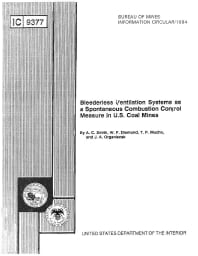Mining Publication: Bleederless Ventilation Systems as a Spontaneous Combustion Control Measure in U.S. Coal Mines
Original creation date: January 1994
Authors: AC Smith, WP Diamond, TP Mucho, JA Organiscak
NIOSHTIC2 Number: 10004943
Pittsburgh, PA: U.S. Department of the Interior, Bureau of Mines, NTIS PB94-152816, IC 9377, 1994 Jan; :1-37
The U.S. Bureau of Mines conducted a worldwide literature review of bleederless ventilation practices to evaluate their use as a spontaneous combustion control measure in U.S. coal mines. Factors that must be taken into account in the design and use of these systems include seal construction, the use of ventilation control devices, the use of methane-drainage systems in gassy mines, and the ground control plan. Monitoring for the detection of spontaneous combustion and the control of methane when methane-drainage techniques are employed is critical to the successful use of a bleederless ventilation system. This report describes the types of ventilation systems used throughout the world and the spontaneous combustion risks associated with these systems. Methane-drainage systems used in conjunction with bleederless ventilation systems are discussed. Ground control considerations such as pillar design, entry stability, and seal usage are reviewed. Monitoring systems for spontaneous combustion detection, methane-drainage control, and behind seals are examined. Finally, methods for evaluating the spontaneous combustion hazard of a mining operation to determine when the use of a bleederless ventilation system is warranted are reviewed.

NIOSHTIC2 Number: 10004943
Pittsburgh, PA: U.S. Department of the Interior, Bureau of Mines, NTIS PB94-152816, IC 9377, 1994 Jan; :1-37